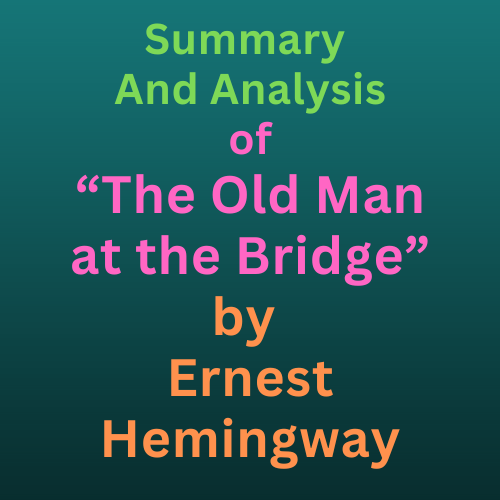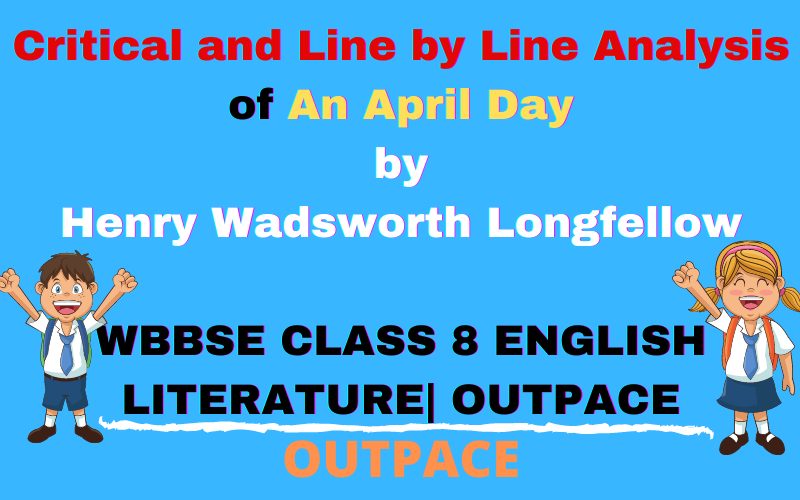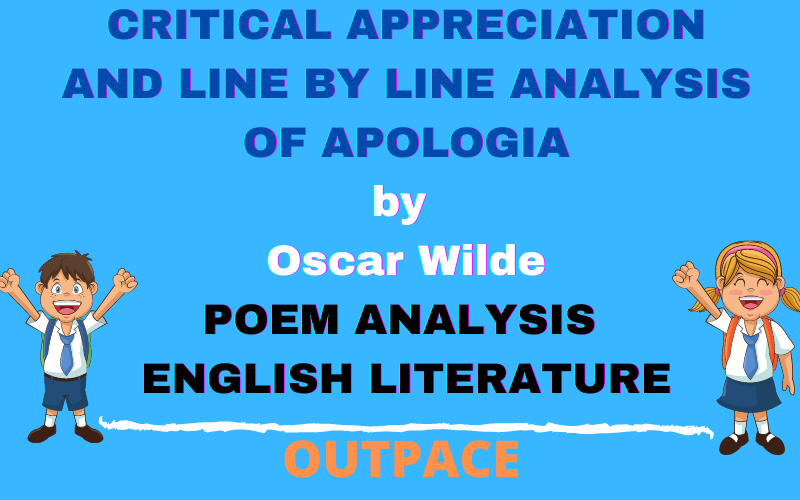Here is a Summary and Analysis of “The Old Man at the Bridge” by Ernest Hemingway. This would provide learners with a proper detail of the poem to comprehend it properly.

Summary of “The Old Man at the Bridge” by Ernest Hemingway
“The Old Man at the Bridge” is a short story by Ernest Hemingway about an old man who is sitting on a bridge during the Spanish Civil War. A soldier comes up to him and asks him where he is going, and the old man explains that he is fleeing the war and trying to find a new place to live.
The soldier tells the old man that he is too old to flee and that he should just stay where he is. The old man insists that he must go, but the soldier tells him that there is no place to go and that the war is everywhere.
The old man then asks the soldier if he will be able to find a place to live, and the soldier tells him that he will not. The story ends with the old man sitting on the bridge, looking out at the war-torn landscape. The story is a commentary on the futility of war and the displacement and suffering it causes.
Analysis of “The Old Man at the Bridge”-PART-1
An old man with steel rimmed spectacles and very dusty clothes sat by the side of the road. There was a pontoon bridge
across the river and carts, trucks, and men, women and children were crossing it. The mule- drawn carts staggered up the steep
bank from the bridge with soldiers helping push against the spokes of the wheels. The trucks ground up and away heading out
of it all and the peasants plodded along in the ankle deep dust. But the old man sat there without moving. He was too tired to
go any farther.
Also Read-THE COLD WITHIN – MCQ QUESTIONS AND ANSWERS – ICSE CLASS 9 AND 10 ENGLISH
It was my business to cross the bridge, explore the bridgehead beyond and find out to what point the enemy had advanced. I
did this and returned over the bridge. There were not so many carts now and very few people on foot, but the old man was still
there.
“Where do you come from?” I asked him.
“From San Carlos,” he said, and smiled.
That was his native town and so it gave him pleasure to mention it and he smiled.
“I was taking care of animals,” he explained.
“Oh,” I said, not quite understanding.
This is an excerpt from the short story “The Old Man at the Bridge” by Ernest Hemingway. The story is set during the Spanish Civil War, and the narrator is a soldier who encounters an old man sitting by the side of the road on a pontoon bridge.
The old man, who is described as having “steel rimmed spectacles and very dusty clothes,” is clearly tired and worn out from his journey. He is surrounded by the chaos and turmoil of the war, as carts, trucks, and people are crossing the bridge and heading away from the conflict.
The narrator, who is on a mission to explore the bridgehead and find out where the enemy has advanced, is initially dismissive of the old man, not understanding his role in the war. He does not understand what it means for the old man to be “taking care of animals.”
The old man is displaced, a victim of the war, and his only concern is to find a safe place, probably with his animals, where he can live. The narrator’s encounter with the old man serves as a reminder of the human cost of war, as the old man is just one of many innocent civilians who have been forced to flee their homes and leave everything they know behind.
Furthermore, the passage also exemplifies Hemingway’s writing style which is characterized by minimalistic, clear and precise language. He uses simple, short sentences and a straightforward narrative to convey the story’s themes. The passage also uses imagery to convey the chaos and turmoil of the war, as well as the old man’s exhaustion and displacement.
Analysis of “The Old Man at the Bridge”-PART-2
“Yes,” he said, “I stayed, you see, taking care of animals. I was the last one to leave the town of San Carlos.”
He did not look like a shepherd nor a herdsman and I looked at his black dusty clothes and his gray dusty face and his steel
rimmed spectacles and said, “What animals were they?”
“Various animals,” he said, and shook his head. “I had to leave them.”
I was watching the bridge and the African looking country of the Ebro Delta and wondering how long now it would be
before we would see the enemy, and listening all the while for the first noises that would signal that ever mysterious event
called contact, and the old man still sat there.
“What animals were they?” I asked.
Also read-Summary-And-Analysis-of-I-Wandered-Lonely-as-a-Cloud-Daffodils-by-WILLIAM-WORDSWORTH
“There were three animals altogether,” he explained. “There were two goats and a cat and then there were four pairs of
pigeons.”
And you had to leave them?” I asked.
“Yes. Because of the artillery. The captain told me to go because of the artillery.”
“And you have no family?” I asked, watching the far end of the bridge where a few last carts were hurrying down the slope
of the bank.
“No,” he said, “only the animals I stated. The cat, of course, will be all right. A cat can look out for itself, but I cannot think
what will become of the others.”
In this passage, the old man is explaining to the narrator why he stayed behind in his hometown of San Carlos, and why he is now sitting on the bridge, looking tired and worn out. He reveals that he stayed behind to “take care of animals” and that he was the last one to leave the town.
The narrator is initially confused by this, as the old man does not look like a shepherd or herdsman. He observes the old man’s dusty clothes and gray face, and expresses surprise at the mention of animals.
The old man then explains that he had to leave behind three animals: two goats and a cat, and four pairs of pigeons. The reason he had to leave was “because of the artillery” and the captain ordered him to leave. The old man expresses his concern for the animals, especially the goats and pigeons, as they are not able to fend for themselves like the cat. He is worried about their fate, which is left uncertain.
The passage provides further insight into the old man’s character, showing him as a compassionate and caring person, who is deeply attached to his animals and concerned about their well-being.
It also serves as a reminder of the human cost of war, as the old man is forced to leave behind his beloved animals and flee his home due to the violence and destruction caused by the artillery. The passage again uses imagery to convey the old man’s exhaustion and displacement, and the narrator’s detachment from the reality of war.
Analysis of “The Old Man at the Bridge”-PART-3
“What politics have you?” I asked.
“I am without politics,” he said. “I am seventy-six years old. I have come twelve kilometers now and I think now I can go
no further.”
“This is not a good place to stop,” I said. “If you can make it, there are trucks up the road where it forks for Tortosa.”
“I will wait a while,” he said, ” and then I will go. Where do the trucks go?”
“Towards Barcelona,” I told him.
“I know no one in that direction,” he said, “but thank you very much. Thank you again very much.”
He looked at me very blankly and tiredly, and then said, having to share his worry with someone, “The cat will be all right, I
am sure. There is no need to be unquiet about the cat. But the others. Now what do you think about the others?”
You are reading -Analysis of “The Old Man at the Bridge”-PART-3
“Why they’ll probably come through it all right.”
“You think so?”
“Why not,” I said, watching the far bank where now there were no carts.
“But what will they do under the artillery when I was told to leave because of the artillery?”
“Did you leave the dove cage unlocked?” I asked.
“Yes.”
“Then they’ll fly.”
“Yes, certainly they’ll fly. But the others. It’s better not to think about the others,” he said.
“If you are rested I would go,” I urged. “Get up and try to walk now.”
“Thank you,” he said and got to his feet, swayed from side to side and then sat down backwards in the dust.
Also read-THE HEART OF THE TREE || A CRITICAL APPRECIATION || ICSE CLASS X ENGLISH || OUTPACE
“I was taking care of animals,” he said dully, but no longer to me. “I was only taking care of animals.”
There was nothing to do about him. It was Easter Sunday and the Fascists were advancing toward the Ebro. It was a gray
overcast day with a low ceiling so their planes were not up. That and the fact that cats know how to look after themselves was
all the good luck that old man would ever have.
The text is a conversation between the narrator and an old man sitting at a bridge. The old man is tired and has come 12 kilometers on foot. The narrator tries to encourage the old man to continue on to the trucks heading towards Barcelona, but the old man is hesitant.
He expresses concern for the animals he left behind and the fact that he left the dove cage unlocked. The narrator reassures him that the animals will be fine and that it’s better not to think about them.
The old man is unable to continue on and the narrator leaves him there, unable to do anything more. The setting is on Easter Sunday during a war, and the Fascists are advancing. The weather is gray and overcast, preventing planes from flying. The old man’s only good luck is that cats can look after themselves.


